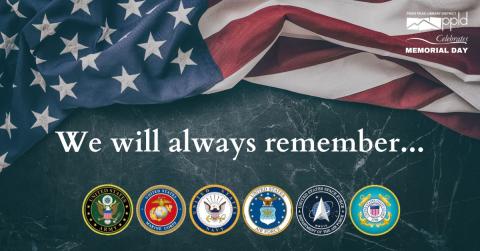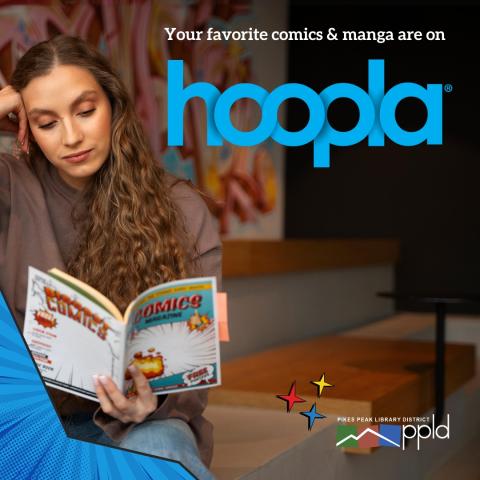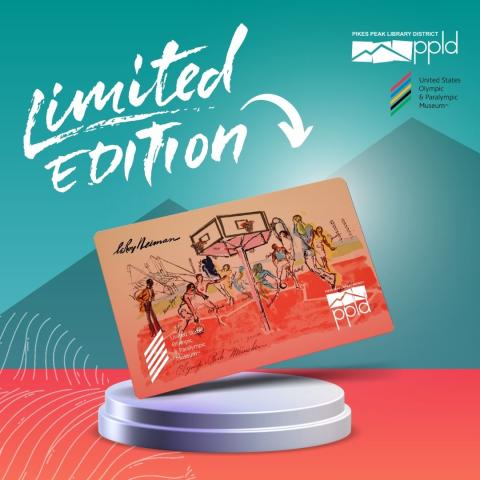Categories

Memorial Day is a day to remember those who have fallen in service to our country. It was originally called Decoration Day from the tradition of decorating graves of the fallen with flowers, wreaths, and flags. While it was first widely observed on May 30, 1868 to commemorate the service of Civil War soldiers, after World War I it was expanded to honor those who had died serving the U.S. in any war. Congress designated the last Monday of May as Memorial Day as part of the Uniform Monday Holiday Act passed in 1971.
Booklists
PPLD Resources
Books
Books about the military can be found in our nonfiction and juvenile nonfiction sections. Look for these call numbers to find where these books are located:
- 355 – Military Science
- 623 – Military Engineering
- 973 – U.S. History
- Gale In Context: Elementary: Memorial Day
Explore facts and history about Memorial Day with the kids in your life. (Must have a library card that starts with a 4 to access outside of a Library location.) - Gale In Context: U.S. History: Memorial Day
Experience Memorial Day in new ways through videos, articles, biographies, images, and more in this history database. (Must have a library card that starts with a 4 to access outside of a Library location.)
Websites
- Memorial Day (Visit Colorado Springs)
Find out about Memorial Day events and activities coming up in Colorado Springs and the surrounding area. - 9 Things You May Not Know About Memorial Day (History Channel)
What do modern Memorial Day celebrations have in common with ancient traditions? Who organized one of the earliest Memorial Day commemorations? What town was the real birthplace of Memorial Day? Read this article to learn more! - Celebrating America’s Freedoms (U.S. Department of Veterans Affairs)
Explore the origins of Memorial Day and find out how different states celebrate. - The History of Memorial Day (PBS)
Learn about the origins of Memorial Day, and visit the Wall of Remembrance to share memories about service members in your life or view memories left by others. - Memorial Day: A Commemoration (National Archives)
View videos, articles and blogs, and more about Memorial Day from the National Archives. - The WWI Origins of the Poppy as a Remembrance Symbol (History Channel)
The poppy hasn’t always been a symbol of remembrance. Learn the WWI origins of this well-recognized symbol.

Free Comic Book Day on Sat., May 4 wasn’t the only way for you to enjoy comics at no cost. Use your library card to access hundreds of comics, graphic novels, and manga on Hoopla! From superheroes and literary adaptations to kid favorites, both new and long-time comic and manga readers can find something to enjoy in this digital collection. Check out what’s available from anywhere using the Hoopla app or by visiting Hoopla using your internet browser.
Hoopla’s digital comics collection is always growing. They added manga in 2023 and continue to add new content each month. The collection offers comic issues, comic volumes, graphic novels, manga, and audiobook adaptations of some graphic novels.
Hoopla’s digital comics collection is always growing. They added manga in 2023 and continue to add new content each month. The collection offers comic issues, comic volumes, graphic novels, manga, and audiobook adaptations of some graphic novels.
Whether you’re new to comics or a longtime fan, Hoopla’s comics section is easy to navigate. You can search for a comic by title or enjoy browsing a wide variety of categories to help you find what you like to read. If you aren’t sure what you want to read, browse through categories like Popular Comics, Featured, Media Tie-In, Fantasy, Historical, and other categories. There’s something for everyone.

Help celebrate the Paris 2024 Olympic Games and Team USA with a limited-edition U.S. Olympic & Paralympic Museum (USOPM) library card! This beautiful commemorative card will be available starting Fri., May 31 just in time for Pikes Peak Library District’s (PPLD) 2024 Summer Adventure presented by Children’s Hospital Colorado reading program.
The card features artwork by LeRoy Neiman, the official painter for five Olympic Games, and now PPLD cardholders can enjoy his artwork on their library card.
As a special bonus, the limited-edition library card can be used this summer for free children’s admissions at the U.S. Olympic & Paralympic Museum. From May 31 – July 31, Library cardholders may present the limited-edition card upon entry at the museum for free admission for a child 12 years of age and younger with a paying adult. The card will be available on a first-come basis, while supplies last.
Don't miss this special library card that will help get you in the spirit of the games this summer!



 Ruth Holley Library will be temporarily closed for approximately one week starting Mon., Dec. 2 to complete roof repairs.
Ruth Holley Library will be temporarily closed for approximately one week starting Mon., Dec. 2 to complete roof repairs.